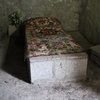Disclaimer
This entry contains information known to us from a variety of sources but may not include all the information currently available. Please be in touch if you notice any inadvertent mistakes in our presentation or have additional knowledge or sources to share. Thank you.
Archive
Grave of Asenath Barzani in Amediye, Iraq
Asenath Barzani, the first known female rabbi, lived in Mosul, Iraq in the 17th century. A daughter of a prominent rabbi, scholar, and mystic, she ran a powerhouse yeshiva, passing on her love for studying the Torah and scholarly work. Her legacy still continues to live on today, which is evidenced by the way many Iraqi Jews make pilgrimages to her grave in Kurdistan.
Description
Asenath Barzani, who lived from 1590 to 1670 in Mosul, is widely regarded as the first known female rabbi in Jewish history. She was the daughter of the eminent Rabbi Shmuel b. Netanel Ha-Levi of Kurdistan, who built a yeshiva in Mosul to train and educate a younger generation of male Jews in Kurdistan to become community leaders and scholars themselves. Though he lived in poverty, he was still revered and held great authority over Jewish education in Kurdistan (1). As he had no sons, the rabbi trained his daughter since her early years and raised her to be a scholar of the highest caliber, despite her gender. In a letter, she described her unusual upbringing:
“I never left the entrance to my house or went outside;
I was like a princess of Israel...
I grew up on the laps of scholars, anchored to my father of blessed memory.
I was never taught any work but sacred study, to uphold, as it is said:
“And you should recite it day and night (Joshua 1: 8)” (2)
Her father married her to one of his best students in the yeshiva, Rabbi Jacob Mizrahi, and made his son-in-law promise that he would not allow Asenath to engage in domestic work so she could spend time in her scholarly studies. Though her husband began to head the yeshiva in Mosul with her father’s passing, Asenath essentially assumed the duties of teaching rabbinic studies to the students. When Rabbi Mizrahi died, the headship of the yeshiva naturally passed to her. However, the yeshiva had struggled with financial constraints during her father’s and husband’s leadership, and transferred over to her time as the yeshiva head. In some of her extant letters, Asenath had to request funds from friends because her home and belongings had been confiscated due to financial instability (3). Her other surviving letters also demonstrate her impressive and thorough knowledge of Hebrew, Talmud, Torah, Midrash and Kabbalah, as well as praise she received from her colleagues for her scholarly knowledge and grasp of the Jewish law (4). In 1664 for example, Rabbi Phinehas Ḥarīrī wrote in a letter to her: “Go kiss her hand, for she is your Lady and prostrate before her,” while referring to her as “Master, Rabbi, and Teacher" (5). There was also considerable mysticism associated with her, as many ill patients were taken to her in hopes of being cured. One particular event that memorialized Asenath into a legendary figure in Kurdistan, occured when she reportedly saved Torah scrolls and holy texts from a burning synagogue by reciting some verses. When fire broke out in the synagogue, where Asenath was celebrating a Jewish holiday with the Jewish community of Amediye, Asenath was able to calm and extinguish the fire by her recitations. The ruins of this synagogue still stand in Amediye under her honor (6).
Her yeshiva produced successful scholars and her son, who she sent to Baghdad, carried on the familial line of rabbinic scholars (7). Her grave which is located in Amediye, Kurdistan, where her father is also buried, has become a pilgrimage site for Jews in Iraq to find healing and offer prayers (8).
Sources
“Asenath Barazani,” Memim Encyclopedia. http://memim.com/asenath-barzani.html
"Kurdish Asenath Barzani," Ekurd Daily. September 10, 2010. Accessed July 25, 2015. http://ekurd.net/mismas/articles/misc2010/9/state4196.htm
Melammed, Renée Levine. Encyclopedia of Jews in the Islamic World. s.v. "Asenath Barazani (Barzani)." Brill Online, 2015. Accessed July 20, 2015. http://referenceworks.brillonline.com/entries/encyclopedia-of-jews-in-the-islamic-world/barazani-barzani-asenath-SIM_0003190
Melammed, Renee Levine. Jewish Women: A Comprehensive Historical Encyclopedia. “Asnat Barazani". Jewish Women's Archive. Quoted from: Mann, Jacob. Texts and Studies in Jewish History and Literature, Vol. I. (New York: 1972), 511. Accessed July 20, 2015.
Footnotes:
[1] Renée Levine Melammed. Encyclopedia of Jews in the Islamic World. s.v. "Asenath Barazani (Barzani)." Brill Online, 2015. Accessed July 20, 2015.
[2] Renee Levine Melammed. Jewish Women: A Comprehensive Historical Encyclopedia. “Asnat Barazani". Jewish Women's Archive. Quoted from: Mann, Jacob. Texts and Studies in Jewish History and Literature, Vol. I. (New York: 1972), 511. Accessed July 20, 2015.
[3] Melammed. Jewish Women: A Comprehensive Historical Encyclopedia. “Asnat Barazani".
[4] Melammed. Encyclopedia of Jews in the Islamic World. “Asenath Barazani (Barzani).”
[5] Melammed. Encyclopedia of Jews in the Islamic World. “Asenath Barazani (Barzani).”
[6] "Kurdish Asenath Barzani," Ekurd Daily. September 10, 2010. Accessed July 25, 2015. http://ekurd.net/mismas/articles/misc2010/9/state4196.htm
[7] Melammed. Jewish Women: A Comprehensive Historical Encyclopedia. “Asnat Barazani".
[8] “Asenath Barazani,” Memim Encyclopedia. http://memim.com/asenath-barzani.html


